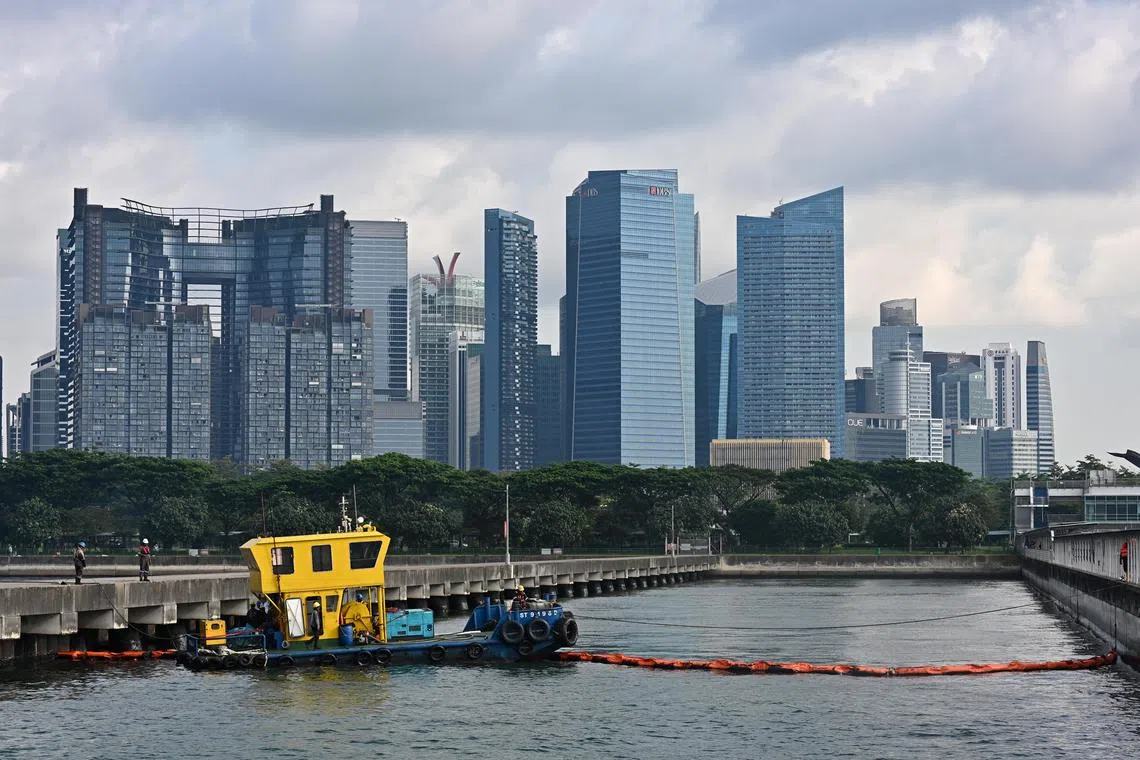News analysis
SOPs, response times: S’pore’s efforts in dealing with oil spill scrutinised in the House
Sign up now: Get ST's newsletters delivered to your inbox

A skimmer craft lifting oil off the water at Marina South Pier on June 18.
ST PHOTO: LIM YAOHUI
Follow topic:
SINGAPORE - Nearly three weeks after a maritime accident led to 400 tonnes of fuel leaking from a damaged vessel, smearing Singapore’s beaches and shorelines, the oil spill remains a talking point.
Could the spill on June 14 have been better contained? What are the economic costs and environmental impact, and will small businesses hit in the pocket be given help?
These were among the questions uppermost on MPs’ minds during the Parliament sitting on July 2, as government leaders helming the response to the spill at Pasir Panjang Terminal delivered ministerial statements.
Transport Minister Chee Hong Tat, Minister for Sustainability and the Environment Grace Fu, and National Development Minister Desmond Lee responded to 40 questions on the incident, filed by 23 MPs from both sides of the political aisle.
These ran the gamut. Ms Nadia Ahmad Samdin (Ang Mo Kio GRC) asked about the standard operating procedures (SOPs) for containing spills, while other MPs – including Mr Alex Yam (Marsiling-Yew Tee GRC) and Mr Edward Chia (Holland-Bukit Timah GRC) – wanted to know the estimated costs of the cleanup.
The high-level attention being paid to the issue was borne out not just by the one hour and 40 minutes of airtime it was given in the House.
Eight days before the parliamentary debate, the same three Cabinet ministers spent slightly more than an hour and 10 minutes at a press conference sketching out Singapore’s cleanup efforts.
On June 14, at 2.18pm, a Netherlands-flagged vessel, Vox Maxima, lost engine and steering controls, hitting a Singapore-flagged bunker vessel, Marine Honour, which was berthed at Pasir Panjang Terminal.
The next day, the oil that escaped from Marine Honour had washed ashore in areas such as Sentosa and East Coast Park.
The response to the spill – in particular the time it took to lay containment booms around the damaged bunker vessel – came under scrutiny again in Parliament on July 2.
It took a contractor nearly 15 hours to complete the deployment of the booms, hampered by a thunderstorm and nightfall
Workers’ Party (WP) MP Louis Chua (Sengkang GRC) asked about Singapore’s required response times to oil spills of varying severity.
In response, Mr Chee said it was “difficult to have a precise, single number” because “every oil spill is different”.
The scale of the spill, the area’s geography and oil density play a part.
“In some instances, the oil may not float very far away. In some instances, it may float farther away.
“In some instances... the oil density makes it easier to detect because it floats on the surface. In this case, it was an added challenge because this oil has (a) similar density (to) seawater, so it could go below the surface.”
For these reasons, “there isn’t a single number that you can say, Oh, did you meet this (number of) hours?”, the Transport Minister said. “It’s not quite like that.”
At several points in Parliament – as he did at the press conference – Mr Chee stressed that the authorities and their contractors followed international industry practices to contain the spill.
In the first instance, dispersant was sprayed to break down the spilled oil, to pave the way for cleanup efforts.
Booms were then laid around the damaged vessel.
Contractor T&T Salvage Asia fully deployed 200m of booms at 5.15am on June 15. The contractor needed more time as it had to load its vessel with heavy equipment and set about the laborious task of laying the booms amid bad weather and nightfall.
Mr Chee said T&T did its best given the circumstances, and its response time was in line with industry practices internationally.
He explained that currents and waves would have carried the spilled oil away from the accident site, and hence, the booms were not meant to ring-fence the oil that has already leaked.
Rather, they were to prevent further spills from the vessel, which still had vast amounts of fuel in its tanks.
WP MP Gerald Giam (Aljunied GRC) rose twice to ask if the booms could have been deployed more quickly.
Mr Chee replied that the practices used in response to the oil spill have been developed over the years by experts, and “this is how it is done internationally, not just in Singapore but also in other parts of the world”.
While the minister said “there is no disagreement that faster is better”, he made the point that even in the best circumstances, there will be a gap between a large oil spill and when booms are fully deployed.
What, then, is the most effective tool against large oil patches? Skimmers that lift oil from the water surface into storage tanks.
In this case, the challenge for the Maritime and Port Authority of Singapore (MPA) and its contractors was in locating those patches – an effort also hampered by poor visibility and nightfall.
They were able to do so only on the morning after the spill
Another question was whether it made economic sense to have in-house capacity to contain oil spills, instead of engaging contractors.
Mr Chee said the MPA has in-house capabilities, such as vessels, for this purpose.
But, given the nature of spills, Mr Chee said the Republic wants to tackle them in two ways:
Fostering “good collaborations” with its neighbours to ensure a coordinated response during spills; and
Working with contractors who are experts in various areas, including laying booms and skimming oil.
Cautioning against a binary view that “everything has to be in-house, or everything has to be outsourced”, he said: “We need both.”
One key takeaway from the debate was that it takes all hands on deck to contain an oil spill. It is impossible for the authorities to go it alone.
Aside from response times and SOPs, it was heartening to hear other MPs asking after the well-being of the cleaners driving the cleanup, who toil largely unseen.
For instance, Ms Yeo Wan Ling (Pasir Ris-Punggol GRC) wanted to know if measures were in place to ensure cleaners get ample rest, while WP MP He Tingru (Sengkang GRC) asked if workers and volunteers had reported health concerns.
Responding, Ms Fu said workers whom she spoke to said they were being given time to rest and hydrate. There has not been feedback on workers or volunteers suffering from the ill effects of oil inhalation.
The timeliness of the Government’s communications on the spill was also a point of discussion.
Mr Chee said the MPA and other agencies issued five media statements in the first four days.
MPA had first alerted the public to the spill at about 6pm on June 14 via a statement, after the incident happened at 2.18pm. The authority said some oil from Marine Honour’s damaged tank had spilled into the water, but “the affected cargo tank has been isolated and the spill contained”.
While the authorities must be lauded for the regular updates in the days after the spill, some have suggested that more information could have been provided on the potential spread of oil to the beaches the day after.
As the cleanup moves into the next phase targeting hard-to-reach areas, attention is shifting towards the spill’s impact on biodiversity.
Mr Lee said the authorities will, for instance, undertake scientific research with scientists, to better understand the spill’s longer-term impact.
Ultimately, though, the risk of an oil spill is ever-present.
“While we do our best to reduce the risks, oil spills may still happen in our waters or in the region,” Mr Chee said. “It is not possible to completely eliminate this risk.”
He added: “We will continue to update and improve our SOPs and contingency plans with learning points from this incident, and prepare our teams to deal with oil spills effectively through training and regular inter-agency exercises.”
Given the profound effects the spill has had on society, it is imperative to closely examine what had been done right and what could have been improved.
This is so that if the next spill hits, Singapore can respond even more swiftly to limit the impact on its people, the environment and businesses.


